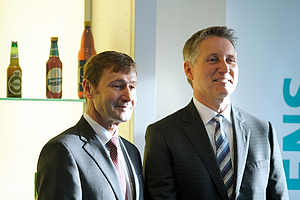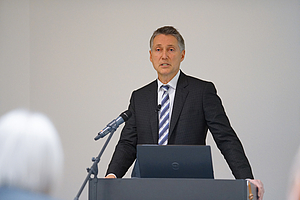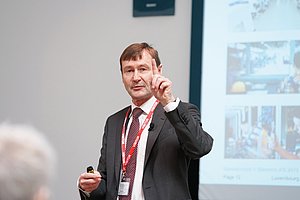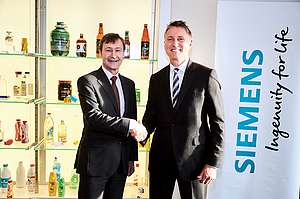

Husky Injection Molding Systems unveils a new groundbreaking digitalized end-to-end manufacturing execution process.
You do not realize a quantum leap with the end-to-end manufacturing execution process if only the chips on the milling machine fly a bit faster in production. Husky’s NGOM in Luxembourg is pursuing optimization through digitization. Optimization of processes, which involve the handling of the customer inquiry up to the delivered tool, purposefully to continue being competitive in the future. And another effect comes up: Production revenue throughout the industry has shifted dramatically to China over the last several years. Digitalization can help to bring back some of the production value to Europe and North America that has been shifted to Asia (Fig. 1). Husky hosted a one-day event at its EMEA headquarters in Dudelange, Luxembourg to officially unveil its digital, state-ofthe-art Next Generation Operating Model (NGOM).

FIG 1: Production had moved forwards to China and Asia (Klaus Helmrich, Siemens, presented in Dudelange, Luxembourg, 6 February 2019), Source: IHS Q4 2018

The event showcased how the company has partnered with the Luxembourg Government Departments of Economy and Labor, as well as fellow industry leader Siemens, to develop a pioneering new digitalized NGOM molding solution.
John Galt “Ultimately for Husky our investment in digitalization will establish a new global operating model that will influence the way we do business everywhere.”
Under the name “Factory of the Future” or NGOM, the system implemented is the subject of a research and innovation project by Husky in cooperation with Siemens amounting to around 11 million euros. Both companies are based in Luxembourg: Husky with a production site, Siemens with a technical basis for the digitization of industrial processes. The R&D project was supported by the Ministry of Economy of Luxembourg for around 3.4 million euros.
The industry faces ever more complex demands from its customers (Fig. 2; CC has reported these requirements in the ONE:15 issue). With NGOM, Husky can now offer solutions with high added value - while streamlining production costs and adding a new dimension of speed and flexibility.

FIG 2: The demands made on the suppliers (packaging/machinery) are growing all the time / 1, 2, 3/.

John Galt “What it means to our customers in the short term: We believe we can deliver faster with better quality. And that matters a lot in today’s environment.
For Luxembourg’s Deputy Prime Minister and Minister of Economy Étienne Schneider, the project is a concrete example of Luxembourg’s strategy to promote digital innovation. “As a forward-looking project, the Factory of the Future is fully integrated into our sustainable economic development policy, which targets the use of digital technologies in the high-tech industry.” He thanks Husky and Siemens for their commitment in Luxembourg.
John Galt, President and CEO of Husky, emphasizes that the new program is revolutionizing processes and ways of working: “Husky recognizes the significant impact of digitization in all areas and has worked with our partners, most notably Siemens, at all levels to develop our sustainable digital manufacturing capabilities and processes.” He congratulates the Luxembourg government on its forward-looking approach to helping companies make the transition to the digital world. This allows them to meet the rapidly changing needs of the industry. Galt is steadfast in his conviction that Luxembourg is and will remain a preferred location for Husky. Not only his personal connection - Galt lived with his family for 5 years in Luxembourg - but because of the always positive experience as an “excellent place for doing business” - he was pleased to accept the support program of the country Luxembourg. “Luxembourg is the perfect home to create a world-class digitalization facility.”

According to Klaus Helmrich, Member of the Board of Siemens, a growing number of industrial companies around the world are already improving their competitiveness through digital solutions. This applies to all sectors that are subject to frequent fluctuations in demand and in which production must be faster, more flexible and more tailor-made.
Klaus Helmrich “We’re shaping the future of the industry by integrating more technologies, including artificial intelligence and edge computing, into our service offerings.”
Helmrich concretizes: “Digitalization wants to help a lot to convince the customer that you and your machine are able to produce what the customer wants.” A big change will be that customers and suppliers will be working with digital twins in the future: “The customer will bring a digital twin of his product, describing exactly the bottle details: format, design, features, stability. In a virtual show room and with a digital twin of the machine, customers and suppliers will find the best way to realize the customers’ requests.” The second major change will be that real production processes do not start until functionality is ensured in the virtual environment.

Galt has two motives for being one of the first to approach this concept of digitalization: The first is the chance to meet customer demands and to continue keeping Husky’s customers in the lead. “This idea of driving an increased demand for solutions and the immediacy of the response is changing the nature of our business.” The second is investing in the future. “Husky’s goal is to be a top industrial company. Husky saw digitalization as an opportunity to facilitate both.”
Galt provides insights into internal structures and explains what makes Husky so successful in experiencing and benefiting from digital transformation. These include Husky’s innovative strength: “We have, historically had a very innovation focused DNA.” A clear vision, unconditional will and last but not least Husky has the financial resources to make it possible.
John Galt “In our industry it is important to act out of a position of strength. Husky is an industry leader and we felt that there is no better time to invest in the future.
Galt pays special attention to his employees and sees the golden way in the skills transition: “We have some exceptional people. We believe that our strength in people gave us a great opportunity for skills transition, for teaching people new skills, for leveraging their passion, their intellectual curiosity, their desire to learn and be a leader and in these processes help them develop our business and give them a rewarding career.”
The analysis also includes alleged weaknesses such as unnecessary and wasteful processes, which can be optimized with the help of the digitization process, and from which even advantages can arise: “The fact today that operating out of Luxembourg, operating out of Canada, operating out of the United States means that we have relatively high fixed costs versus many of our emerging competitors. We also looked internally and realized that in many cases we have unnecessarily wasteful processes.”

The challenge has been set with the goal of expanding Husky’s leadership position. Independence and the pioneering role are also important to Galt. “Fundamentally, it is all about controlling your own destiny.” Siemens and the country of Luxembourg are the perfect partners for this: “We selected Siemens because of the range of capabilities they have available from hardware to software, but equally the rate at which they see Industry 4.0 revolutionizing the way that industrial businesses work. We had a partner not only in capability but also a partner in spirit, as we knew there were many things that we had to overcome.”
John Galt “Our objective is to allow our customers to bring their ideas to market with unmatched speed and efficiency.
In 2018, small quantities of cores were produced on the line and through 2019 “we are scaling that up and actually servicing customer orders with the technology.” Over the course of the next couple of years, this new business model is expected to represent more than half of the total revenue Husky is generating. “Products for our Rigid Packaging business will be flowing through this highly industrialized, highly digitalized model.” Galt’s conclusion: “It is very bold, it is extremely ambitious, but again the quality of your partnerships can help you overcome those challenges .”
[1] S. Jeschke. Überanpassung vereitelt technische Revolution; VDI Nachrichten, 19, 8. Mai 2015
[2] Th. Bauernhansl, M. ten Hompel, B. Vogel-Heuser (Hrsg.) Industrie 4.0 in Produktion, Automatisierung und Logistik. Springer Vieweg Verlag 2014
[3] O. Appel, connected world - connected packaging. comPETEnce Magazine ONE:15, 2015
The comPETence center provides your organisation with a dynamic, cost effective way to promote your products and services.

magazine
Find our premium articles, interviews, reports and more
in 3 issues in 2025.



